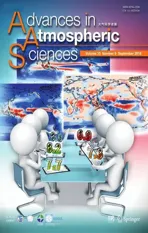In fl uence of Low-frequency Solar Forcing on the East Asian Winter Monsoon Based on HadCM3 and Observations
2018-06-29JiapengMIAOTaoWANGHuijunWANGandYongqiGAO
Jiapeng MIAO,Tao WANG,Huijun WANG,and Yongqi GAO
1Nansen-Zhu International Research Center,Institute of Atmospheric Physics,Chinese Academy of Sciences,Beijing 100029,China
2Collaborative Innovation Center on Forecast and Evaluation of Meteorological Disasters,Nanjing University of Information Science and Technology,Nanjing 210044,China
3Key Laboratory of Meteorological Disaster,Nanjing University of Information Science and Technology,Nanjing 210044,China
4Climate Change Research Center,Chinese Academy of Sciences,Beijing 100029,China
5Nansen Environmental and Remote Sensing Center/Bjerknes Centre for Climate Research,Bergen 5006,Norway
6University of Chinese Academy of Sciences,Beijing 100049,China
1.Introduction
Previous studies have illustrated the in fl uences of solar variability on the climate of Earth(e.g.,Haigh,2001;Lean and Rind,2001;Rind,2002;Meehl et al.,2003;Meehl et al.,2008;Xiao et al.,2017).In the stratosphere,for example,solar-induced ozone changes can a ff ect the temperature and zonal wind distribution,the mechanisms for which have been described in Gray et al.(2010)and many references therein.Correspondingly,the Northern Hemisphere polar vortex responds obviously to the 11-year solar cycle,although it is also in fl uenced by the quasi-biennial oscillation(Labitzke,1987;Labitzke and Van Loon,1988).In the troposphere,the Hadley and Walker circulations strengthen during peak solar years,and the Intertropical Convergence Zone and South Paci fi c Convergence Zone shift poleward(van Loon et al.,2004,2007).Furthermore,observational and modeling studies have reported the in fl uences of solar variability on the North Atlantic Oscillation(NAO)(Shindell et al.,2001;Kodera,2002;Swingedouw et al.,2011;Gray et al.,2013).In addition,the 11-year solar cycle can be detected at the surface of Earth.Meehl et al.(2008)and Meehl and Arblaster(2009)observed a La Ni˜na-like cold event at the peak sunspot number(SSN)followed by an El Ni˜no-like event a few years later.Huo and Xiao(2016)noted that solar activity might have contributed to the El Ni˜no Modoki component of the 2015/16 El Ni˜no event.Furthermore,some studies have indicated that the global surface temperature is signi fi cantly related to the 11-year solar cycle(Tung and Camp,2008;Zhou and Tung,2010;Huo and Xiao,2017).The monsoon rainfalls in India,South Asia,West Africa,and North America also exhibit high correlations with solar variability(Kodera,2004;van Loon et al.,2004).
The East Asian winter monsoon(EAWM),which is the most distinct climate system over East Asia in winter(Lau and Li,1984;Tao and Chen,1987;He et al.,2007),is in fl uenced by both internal variability and external forcings(Ding et al.,2014).For instance,the variability in the EAWM is closely related to the major mode of atmospheric variability,such as the Arctic Oscillation and the NAO(Gong et al.,2001;WuandWang,2002;Sungetal.,2010;Heetal.,2017).The Paci fi c sea surface temperature(SST)also plays an important role in EAWM variability(Yang et al.,2002;Zhou et al.,2007a;Sun et al.,2016),especially the El Ni˜no–Southern Oscillation(ENSO)over the tropical Paci fi c(Zhang et al.,1996,1999;Wang et al.,2000;Zhou et al.,2007b;Wang and He,2012).For example,Wang et al.(2000)indicated that the warm(cold)phase ENSO cycle is typically related to a weak(strong)EAWM and the western North Paci fi c anticyclone(cyclone)acts as a bridge between phases.Additionally,the Atlantic Multidecadal Oscillation(AMO)is associated with the East Asian winter climate(Li and Bates,2007;Wang et al.,2009).Both modeling and observational studies have reported that the warm phase of the AMO can lead to warmer than average conditions in East Asia in boreal winter.Additionally,some recent studies have shown the infl uences of Arctic sea-ice loss and Arctic ampli fi cation on the EAWM,although no consensus has been reached(Wang and Liu,2016;Zhou,2017).From the perspective of external forcing,some studies have projected weakened EAWM low-level northerlies under global warming scenarios(Hu et al.,2000;Hori and Ueda,2006).A recent modeling study suggests that the projected low-level northerly winds could be enhanced over the Northeast Asian coastal region,Southeast Asia,and the South China Sea,but with little change over midlatitude East Asia(Xu et al.,2016).In addition,Jiang et al.(2017),based on CAM5 simulations,suggested that anthropogenic aerosols can intensify the EAWM northern mode.Furthermore,a recent study found that strong tropical volcanic eruptions play an important role in regulating the EAWM(Miao et al.,2016).
However,until recently,the in fl uence of solar variability on the EAWM had received little attention.Those studies that have now explored this topic used reanalysis and observational data from the late 20th century and concluded that the EAWM weakens as solar activity strengthens on the interannual time scale(Weng,2012;Wang et al.,2015).However,the response of the EAWM to solar forcing on a longer time scale remains unclear.Therefore,in this study,we investigate the e ff ect of low-frequency solar variability on the East Asian winter(December,January and February)climate using an ensemble of simulations involving only solar forcing variability,which excludes the in fl uences of anthropogenic agents.Observational and reanalysis data collected before the 1970s are also used in this study.We describe the model,data and methods in section 2.In section 3,we investigate the in fl uence of low-frequency solar forcing on the EAWM.Conclusions and discussion are given in section 4.
2.Model,data and methods
The model used in this study is the Hadley Centre Coupled Model,version 3(HadCM3)(Gordon et al.,2000;Pope et al.,2000).The atmospheric component of HadCM3 is a version of the UKMO’s Uni fi ed Model.The model is run on a 3.75◦×2.5◦longitude–latitude grid and has 19 hybrid levels in the vertical direction.This version incorporates signi fi cant improvements compared to the previous version(Pope et al.,2000).The ocean component is a version of the Cox(1984)model,with a 1.25◦×1.25◦horizontal grid.Six ocean grid squares correspond to one atmospheric model grid square.The ocean model has 20 vertical levels,and the resolution near the ocean surface is enhanced.The atmospheric and ocean models are coupled once daily,and the details can be found in Gordon et al.(2000).HadCM3 can be run without fl ux adjustments,and it has been widely used to simulate past and future climate change.For example,when all anthropogenic and natural forcings are included,the HadCM3-simulated surface air temperature(SAT)agrees well with instrumentaldataandreconstructionensembledatasetsoverthe past millennium(Schurer et al.,2014).More details of the model components and performance can be found in Schurer et al.(2014)and the references therein.
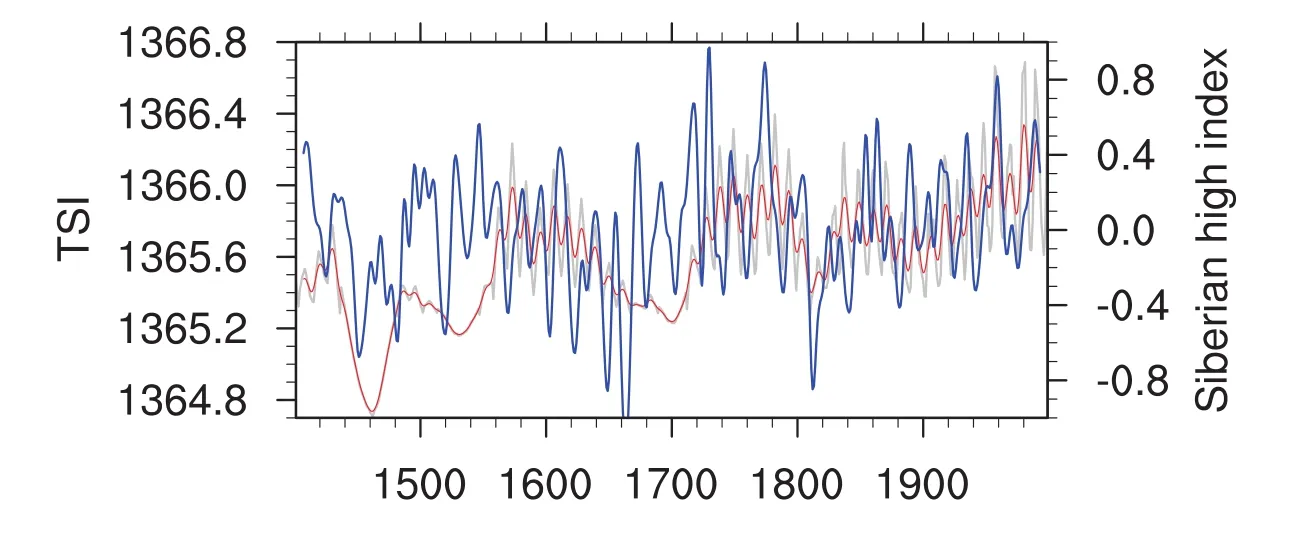
Fig.1.Time series of TSI(units:W m−2)and Siberian high index during 1401–1999.The red(blue)line represents the low-pass fi ltered TSI(Siberian high index)series with a 13-year cuto ffperiod,while the gray line represents the un fi ltered TSI series.
A four-member ensemble of HadCM3 simulations spanning from 1400 to 2000 is analyzed in this study(Schurer et al.,2013).The simulations are run with only solar forcing variability,while other forcings(such as well-mixed green-house gases,land use,and orbital forcing)are set to constants(1400 levels).The solar forcing used here is the reconstruction of total solar irradiance(TSI)from Steinhilber et al.(2009)between 1400 and 1810,and from Wang et al.(2005)between 1810 and 2000.The Wang et al.(2005)reconstruction datasets with and without background information are linearly combined to make the two reconstructions match.The TSI series is shown in Fig.1.The four ensembles are initialized with the same oceanic conditions as those in 1400,but di ff erent atmospheric conditions near the 1400.These conditions are from a long-term simulation of all relevant forcings beginning in 800 AD.More details of the initialization method can be found in Schurer et al.(2014).
In addition,we use sea level pressure(SLP)from Had-SLP2r[Second Hadley Centre Sea Level Pressure dataset near-real time product(Allan and Ansell,2006)]to investigate the in fl uences of solar forcing on the EAWM in the observations.A Siberian high index is de fi ned as the mean SLP over the region(40◦–60◦N,70◦–120◦E)(Gong et al.,2001).The SSN is used to represent the solar variability in the observational analysis(available from http://sidc.oma.be/silso/yearlyssnplot)and is a direct expression of the intensity of solar activity.Thus,we can avoid problems associated with using TSI,which is reconstructed under various assumptions(Gray et al.,2013).
In this study,we focus on the low-frequency climate variability associated with TSI variability.The low-pass Lanczos fi ltering method is applied to the TSI series and all the fi elds with a 13-year cuto ffperiod.Notably,the Schwabe cycle can be fi ltered via this method.The statistical signi fi cance of the regression analyses is estimated using a“random phase”test,which can eliminate the low-pass fi ltering-induced serial correlation e ff ects(Ebisuzaki,1997).
3.Results
3.1.Evaluation of modeled climatology
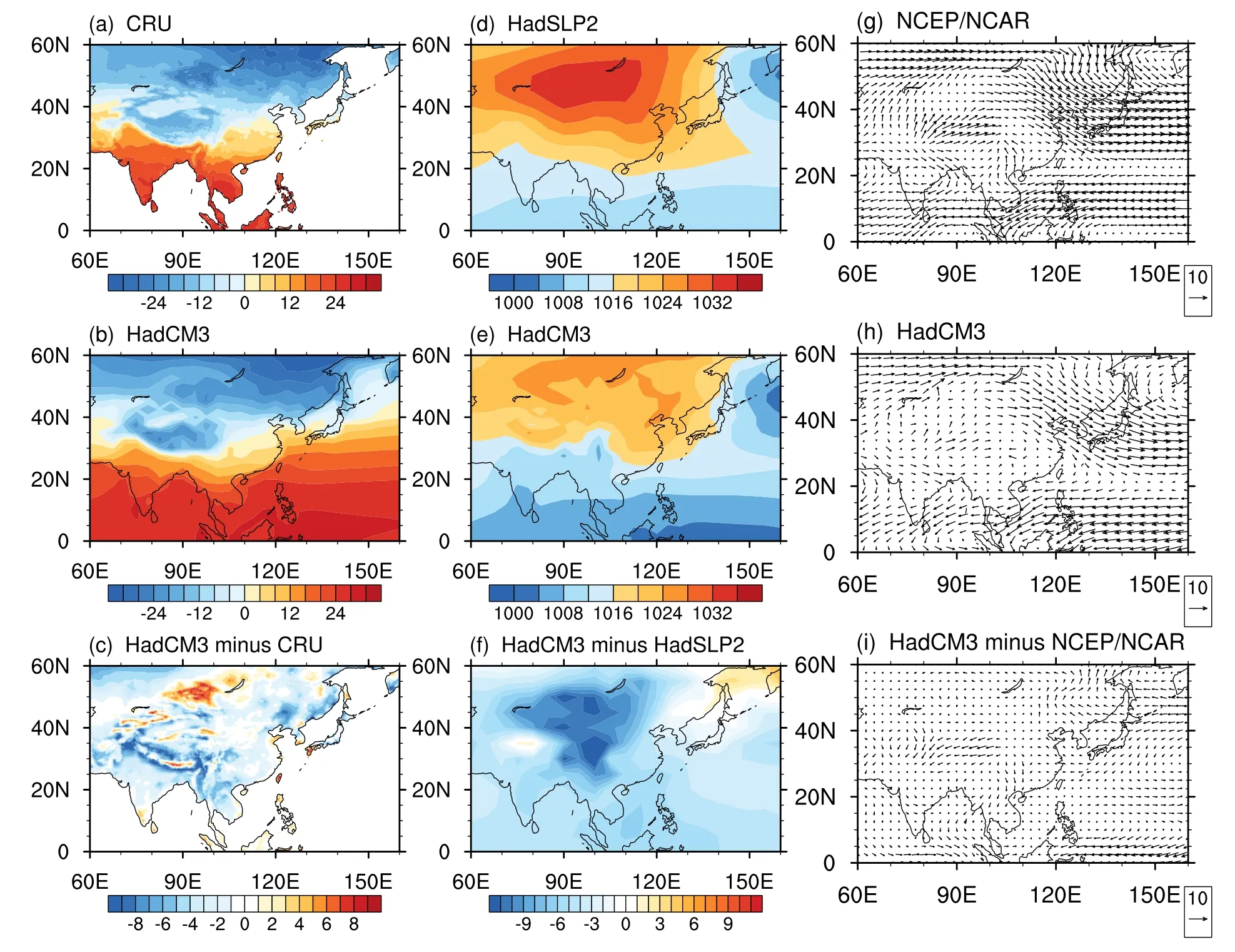
Fig.2.Climatology of winter mean(a)SAT(1901–99;units: ◦C),(d)SLP(1850–1999;units:hPa)and(g)850-hPa winds(1948–99;units:m s−1)based on the observational and reanalysis data.(b,e,h)As in(a,d,g)but based on the HadCM3 model results over the period 1401–1999.(c,f,i)Di ff erences between the model and observational data.
We fi rst evaluate the model climatology over East Asia in winter.This evaluation veri fi es the credibility of the following analysis and the conclusions based on this model.Considering the general characteristics of the EAWM,we examine the climatologies of the SAT,SLP and 850-hPa winds here.As shown in Fig.2b,the simulated SAT is distributed latitudinally and generally decreases northward.Large-scale cooling can be observed over the Tibetan Plateau.This pat-tern agrees well with observations(Fig.2a).However,some biases also exist.The model overestimates the SAT to the west of Lake Baikal and underestimates the SAT over the Tibetan Plateau and in Northeast China(Fig.3c).In winter,the Siberian high and Aleutian low are located over the Asiancontinent andNorth Paci fi c,respectively(Fig.2d).The model almost fully captures the spatial patterns of the two systems,but it does not e ff ectively reproduce the center of the Siberian high(Fig.2e).Additionally,the model underestimates the intensity of the Siberian high(Fig.2f).For the low-level circulation,the EAWM is characterized by the northwesterly winds over northeastern Asia and northeasterly winds over the South China Sea(Fig.2g).Clearly,the model reproduces the wind fi elds well,although some discrepancies exist(Figs.2h and i).Overall,HadCM3 can simulate the large-scale EAWM circulation e ff ectively,and this result supports the following analysis.
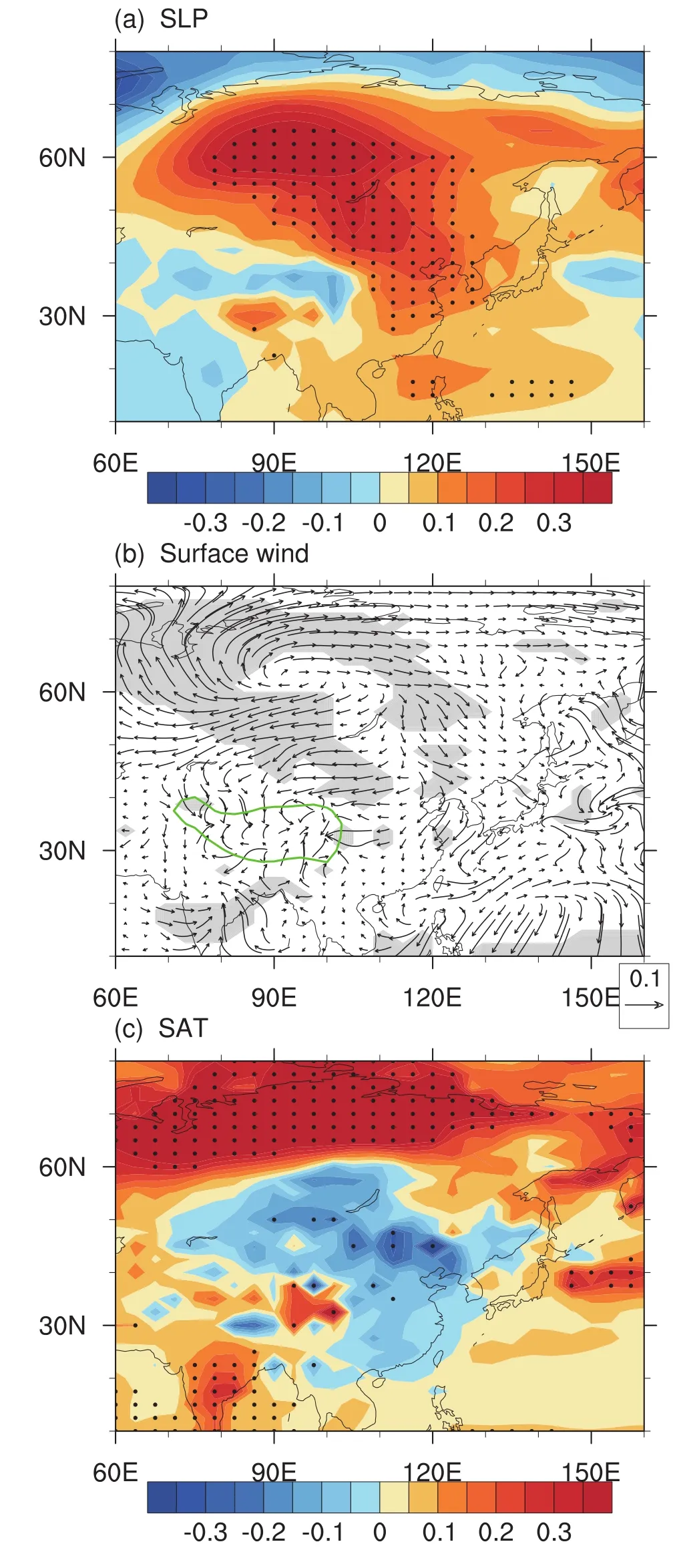
Fig.3.Regression of the winter(a)SLP(units:hPa),(b)surface wind(units:m s−1),and(c)SAT(units:◦C)on the TSI(units:W m−2)during 1401–1999 in the simulation.The TSI and atmospheric variables have been low-pass fi ltered with a 13-year cuto ffperiod.Areas signi fi cant at the 95%con fi dence level are marked with dots in(a,c)but shaded in gray in(b).The green line in(b)shows the 3000 m topographic contour.
3.2.In fl uences of solar forcing on the EAWM in the model
A strengthened Siberian high is often considered a characteristic of a strong EAWM(Guo,1994;Gong et al.,2001).As shown in Fig.3a,anomalously positive SLPs are evident over Siberia and East China when the TSI is high on the multidecadal time scale.These SLPs re fl ect an enhancement of the Siberian high.Their consistent trends can be seen from the time series of TSI and Siberian high index(Fig.1).Both time series exhibit decreasing trends during the periods1401–60,1580–1700,1780–1820and1860–80;whereas,they show increasing trends during the periods 1460–1560,1700–60,1820–60 and 1880–1999.As a result,when the TSI is high,anomalous anticyclones can be observed over the high-latitude Eurasian continent(Fig.3b).Additionally,northerly wind anomalies are present over East Asia,indicating an anomalously strengthened low-level East Asian winter circulation.Correspondingly,more cold air can be brought southward to low-latitude regions.Thus,signi fi cant surface cooling is observed over East and North China(Fig.3c).Overall,the EAWM typically strengthens when solar forcing strengthens in the model.
To understand the possible mechanisms of the intensi fi ed Siberian high,we fi rst examine the response of large-scale atmospheric circulation over the Northern Hemisphere to low-frequency changes in TSI.When TSI is high,positive 500-hPa geopotential height(Z500)anomalies are present over Siberia and southern Iceland(Fig.4a).Correspondingly,negative Z500 anomalies are evident over the Greenland Sea and subtropical North Atlantic.The alternating occurrence of negative–positive–negative–positive anomalies resembles a Rossby wave pattern that propagates from the subtropical North Atlantic to the Siberian region.We further investigate the corresponding qausi-geostrophic stream function and wave activity fl ux(WAF)anomalies,which can re fl ect the propagation of stationary Rossby waves and indicate the direction of energy propagation(Takaya and Nakamura,2001).As shown in Fig.4b,the wave train propagates northeastward from the subtropical North Atlantic to the Iceland basin and then splits into two branches.One branch propagates eastward and reaches the Siberian region.This branch is weak(non-signi fi cant).The other branch continues northward to the Greenland Sea and then swings toward the Siberian region.This northward branch of the Rossby wave is signi fi cantly strengthened when it reaches the Greenland Sea,which is likely due to the positive feedback of sea ice there(Fig.5a).When this wave train reaches the Siberian region,the convergence of the WAF can strengthen the Siberian high.

Fig.4.Regression of the winter(a)Z500(units:m)and(b)500-hPa qausigeostrophic stream function(contours;units:105m2s−1)and WAF(vectors;units:m2s−2)on the TSI(units:W m−2)during 1401–1999 in the simulation.Blue(red)lines represent negative(positive)values,and the contour interval is 105(units:m2s−1)in(b).The TSI and atmospheric variables have been low-pass fi ltered with a 13-year cuto ffperiod.Areas signi fi cant at the 95%con fi dence level are marked with dots in(a)but shaded in gray in(b).
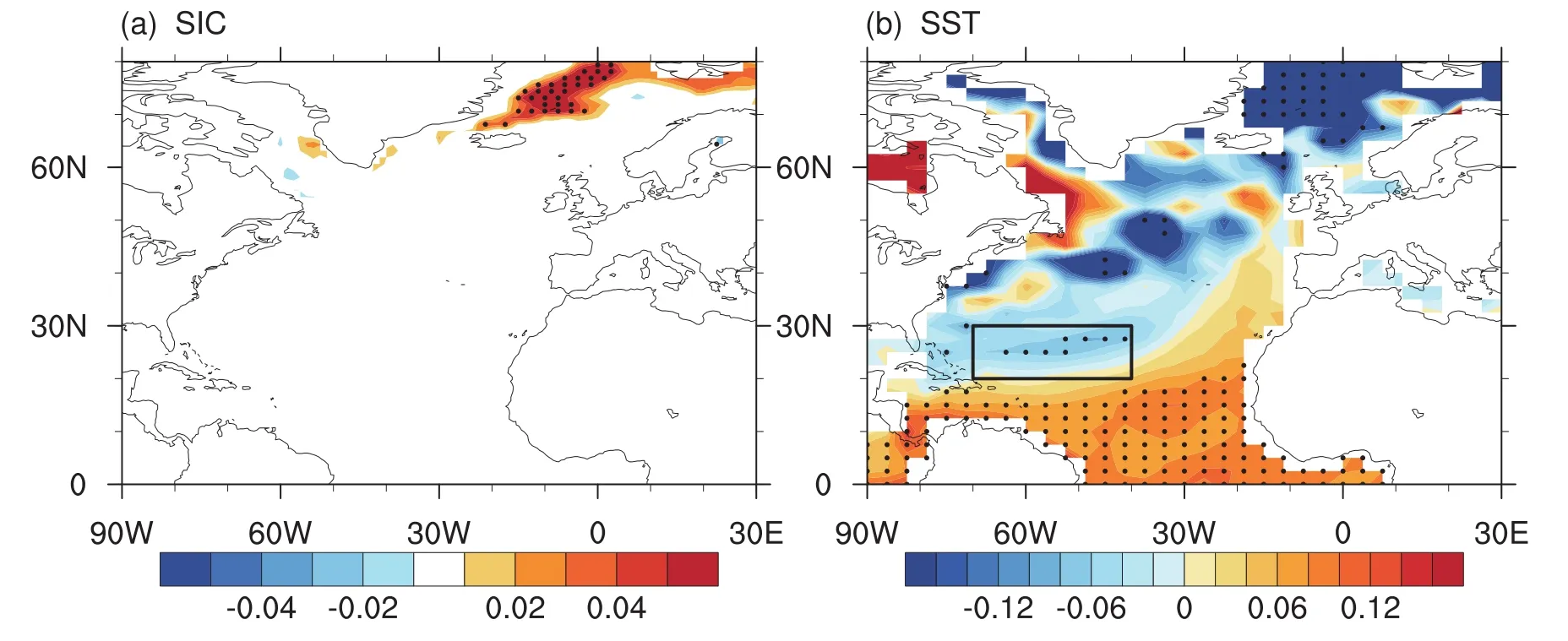
Fig.5.Regression of the winter(a)sea-ice concentration and(b)SST(units: ◦C)on the TSI(units:W m−2)during 1401–1999 in the simulation.The TSI and oceanic variables have been low-pass fi ltered with a 13-year cuto ffperiod.Areas signi fi cant at the 95%con fi dence level are marked with dots.The black frame(20◦–30◦N,40◦–70◦W)in(b)is used to de fi ne a SST-cooling index.
The formation of a Rossby wave is highly correlated with thermal and orographic forcing(Hoskins and Karoly,1981).As shown in Fig.4b,the origin of this wave train is over the subtropical North Atlantic.Thus,it is likely that this negative–positive–negative–positive wave train is excited by negative SST-induced convective heating anomalies over the subtropical North Atlantic(Fig.5b).Signi fi cant cooling over the subtropical North Atlantic can decrease the latent heat fl ux and moisture fl ux to the atmosphere.These changes sub-sequently decrease convective instability.Therefore,convective heating is reduced over the subtropics,and excitation of the Rossby wave train occurs,as illustrated in Fig.4b.The anomaloussubtropicalNorthAtlanticSSTlikelyplaysanimportant role in shaping this Rossby wave train and related atmospheric circulation anomalies over East Asia.To confi rm this inferred linkage,we de fi ne a SST-cooling index over the subtropical North Atlantic(20◦–30◦N,40◦–70◦W;black frame in Fig.5b).The regression maps on it show a similar negative–positive–negative–positive wave train from the subtropical North Atlantic to Siberia(Figs.6a and b).As a result,the Siberian high is signi fi cantly strengthened,causing signi fi cant surface cooling over East Asia(Figs.6c and d).Therefore,the negative SST anomalies over the subtropical North Atlantic are the main reason for the formation of the wave train and the strengthening of the EAWM when TSI is high.However,it should be noted that the southern(northern)branch of the wave train is relatively stronger(weaker)compared to that in the TSI-related process.This suggests that the positive feedback of sea ice over the Greenland Sea probably plays an important role in strengthening the northern Rossby wave in the TSI-related process(Fig.5a).
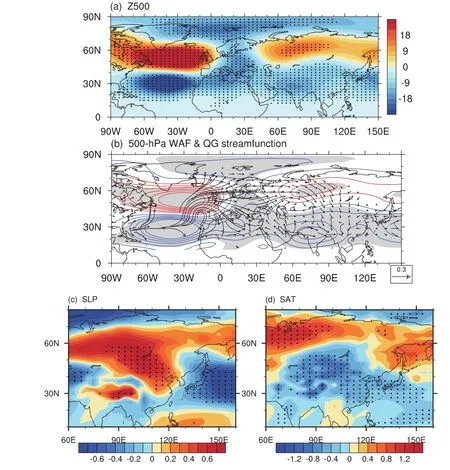
Fig.6.Regression of the winter(a)500-hPa geopotential height(units:m),(b)500-hPa qausi-geostrophic stream function(contours;units:105m2s−1)and WAF(vectors;units:m2s−2),(c)SLP(units:hPa),and(d)SAT(units:◦C)on the SST index(units: ◦C)during 1401–1999 in the simulation.Blue(red)lines represent negative(positive)values,and the contour interval is 5×105(units:m2s−1)in(b).Areas signi fi cant at the 95%con fi dence level are marked with dots in(a,c,d)but shaded in gray in(b).
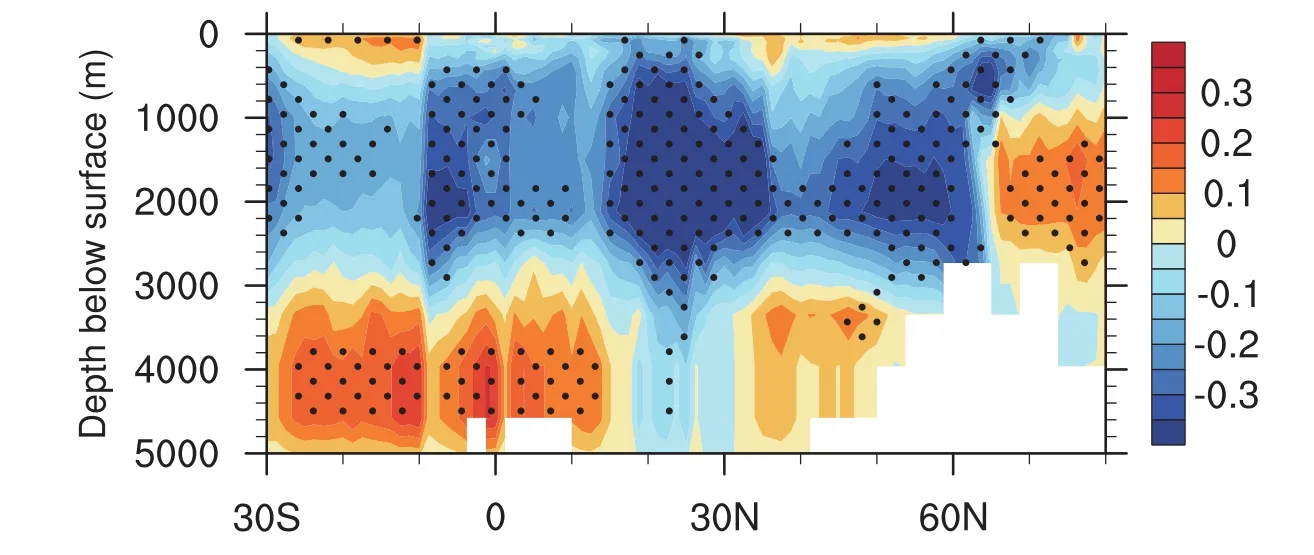
Fig.7.Regression of the winter Atlantic meridional overturning stream function(units:Sv)on the TSI(units:W m−2)during 1401–1999 in the simulation.The TSI and oceanic variables have been low-pass fi ltered with a 13-year cuto ff period.Areas signi fi cant at the 95%con fi dence level are marked with dots.
Thus,the relationship between changes in TSI and negative SST anomalies over the subtropical North Atlantic should be considered.Most regions of the North Atlantic exhibit negative SST anomalies when TSI is high.In contrast,positive SST anomalies can be observed over the entire tropical and South Atlantic.This northern negative and tropical(southern)positive SST anomaly pattern re fl ects the weakening of the Atlantic meridional overturning circulation(AMOC).For con fi rmation,we illustrate the response of the AMOC stream function to solar forcing in Fig.7.Signi ficant negative stream function anomalies across the Atlantic cell indicate a reduction in AMOC strength.In addition,the negative sea surface salinity anomalies in the North Atlantic also indicate a weakened AMOC(Fig.8).As noted in previous modeling studies(Latif et al.,2009;Otterå et al.,2010;Swingedouw et al.,2011),positive TSI anomalies lead to an increase in surface heat fl ux,which induces negative buoyancy forcing and a decrease in mixed layer depth in the Labrador Sea.Thus,the decreased convection in the Labrador Sea can weaken the AMOC.This process is similar to responses of the AMOC to global warming(Gregory et al.,2005).Therefore,the negative SST anomalies over the subtropical North Atlantic are mainly caused by the TSI-induced weakening of the AMOC.Additionally,reduced northward heat transport due to a weakened AMOC decreases the SST in the high-latitude Atlantic(Fig.9),which can increase the sea-ice coverage over the Greenland Sea.This process explains the strengthened wave train in the Greenland Sea area.
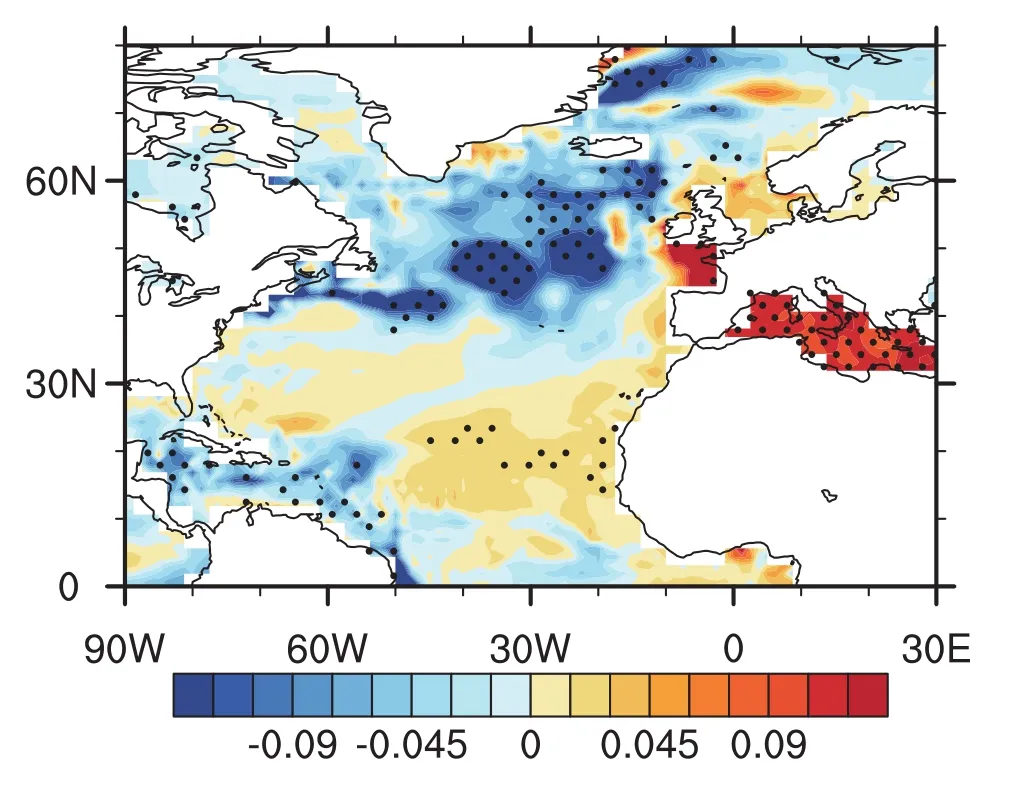
Fig.8.Regression of the winter sea surface salinity(units:psu)on the TSI(units:W m−2)during 1401–1999 in the simulation.The TSI and oceanic variables have been low-pass fi ltered with a 13-year cuto ffperiod.Areas signi fi cant at the 95%con fi dence level are marked with dots.
3.3.Observed in fl uences of solar forcing on the EAWM
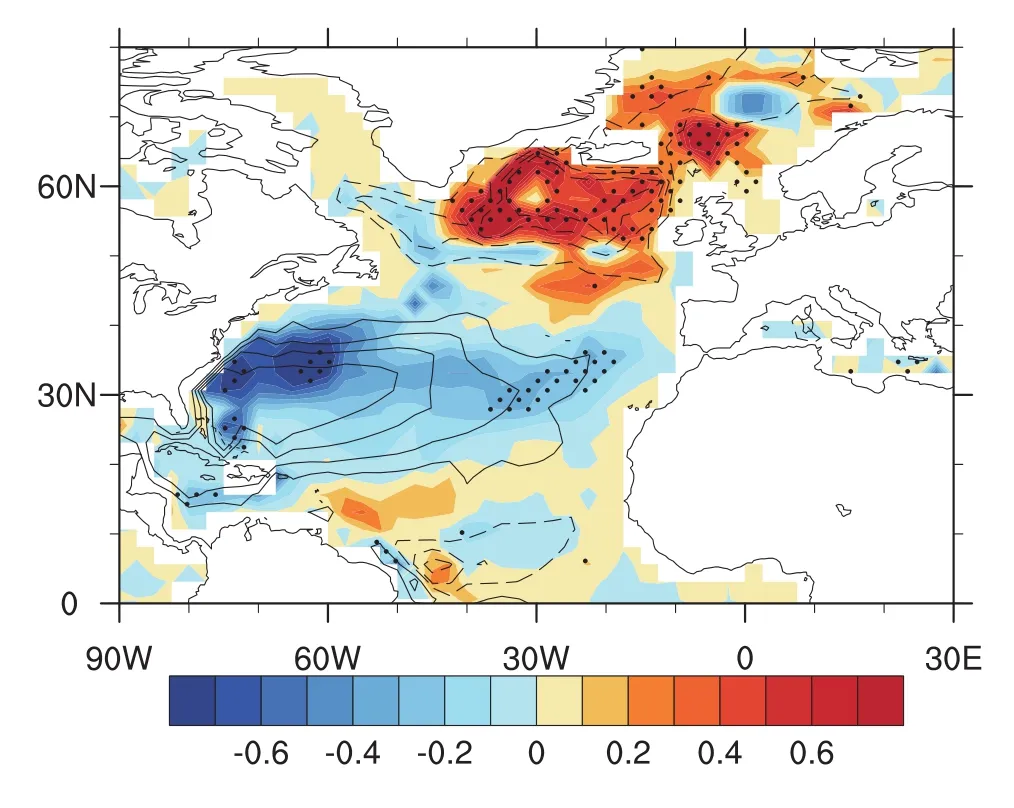
Fig.9.Regression of the winter ocean barotropic stream function(color shading;units:Sv)on the TSI(units:W m−2)during 1401–1999 in the simulation.The TSI and oceanic variables have been low-pass fi ltered with a 13-year cuto ffperiod.Areas signi fi cant at the 95%con fi dence level are marked with dots.The contours show the climatological winter ocean barotropic stream function(interval:5 Sv;zero-line omitted),with solid(dashed)lines meaning positive(negative).
Based on observations,a similar relationship can be found between the low-frequency solar activity and Siberian high during the period 1850–1970.As shown in Fig.10a,both the SSN and Siberian high index exhibit decreasing trends from 1850–1910 and increasing trends from 1910–1970.This means that the SSN and Siberian high index have consistent trends during 1850–1970,similar to the fi ndings from the model results(Fig.1).Figure 10b shows a regression map of the SLP in winter associated with solar forcing during the period 1850–1970.Positive SLP anomalies can be observed over the Siberian region.These fi ndings suggest strong EAWM circulation.However,this relationship reverses after the 1970s.The regression map shows negative SLP anomalies over the high-latitude Eurasian continent when the SSN is high during the period 1971–2014(Fig.10c).

Fig.10.(a)Time series of SSN(red)and Siberian high index(blue)during 1850–2014.(b,c)Regression of the winter SLP(units:hPa 100−1)on the SSN over the period(b)1850–1970 and(c)1971–2014 in the observations.The SSN and atmospheric variables have been low-pass fi ltered with a 13-year cuto ffperiod.Areas signi fi cant at the 90%con fi dence level are marked with dots.
4.Summary and discussion
This study investigates the response of the EAWM to solar forcing in HadCM3.The results suggest that lowfrequency TSI variability plays an important role in regulating the intensity of the EAWM,particularly the Siberian high.The model results show that positive TSI anomalies can weaken the AMOC and cause negative SST anomalies in the North Atlantic.Especially for the subtropical North Atlantic,the negative SST anomalies can excite a Rossby wave train that moves from the subtropical North Atlantic to the Greenland Sea and fi nally to the Siberian region.In this process,the positive sea-ice feedback over the Greenland Sea further enhances the eastward propagation of the Rossby wave.When the wave train reaches Siberia,the Siberian high is strengthened.As a result,northerly wind anomalies are present over East Asia,indicating anomalously strengthened low-level East Asian winter circulation.In addition,surface cooling can be observed over East Asia.Therefore,the EAWM is strengthened due to the high TSI on the multidecadal time scale.
During the period 1850–1970,a similar linkage can be observed between the low-frequency solar activity and the Siberian high.The trends of the SSN and Siberian high index on the multidecadal time scale are consistent.It suggests that higher SSN can lead to a stronger East Asian monsoon circulation.However,this linkage reverses during the period 1971–2014.Why this relationship between the SSN and Siberian high reverses remains unclear.However,complex external forcings,such as rapid increases in greenhouse gas concentrations during the second half of the 20th century,may modulate this relationship.Speci fi cally,the in fl uence of intensive anthropogenic aerosol emissions over East Asia from the 1970s(Wang et al.,2013)on the Asian regional climate is much stronger than that associated with solar activity.These emissions can also modulate the linkage between the SSN and Siberian high.It is well known that the Siberian high controls almost the entire Asian continent in boreal winter,and the corresponding anticyclonic circulation causes northerly winds over eastern China(Gong et al.,2001).The intensity of the Siberian high plays a dominant role in determining the intensity of the EAWM(Guo,1994).As a result,the reversed relationship between the SSN and Siberian high after the 1970s also re fl ects the reversed linkage between the SSN and EAWM circulation.Explanations for this phenomenon require further investigation.
A recent modeling study gives a di ff erent explanation regarding the linkage between the solar activity and SST over the North Atlantic(Thi´eblemont et al.,2015).An anomalous tripolar SST pattern in winter of the peak solar year was found and attributed to the solar maximum–induced positive NAO phase.This is a fast response and it operates on the 11-year solar cycle time frame.However,our study focuses on in fl uences from a low-frequency(longer than 11-year cycle)solar forcing on the EAWM.According to our analysis and a previous modeling study(Swingedouw et al.,2011),there are no signi fi cant relationships between the NAO and TSI at this time scale.In our study,we attribute the SST anomalies over the North Atlantic to the TSI-induced weakening of the AMOC.
In this study,the model does not include stratospheric ozone changes from the ultraviolet part of the solar spectrum.Thus,the mechanism mainly depends on the solar forcing acting on the ocean surface(bottom-up process).Actually,the solar signals in the stratosphere can a ff ect the EAWM through stratosphere–troposphere coupling(top-down process)(Wang et al.,2015).It should be determined whether these two mechanisms act together or play opposing roles in regulating the EAWM.A similar study of the tropical Paci fi c was presented by Meehl et al.(2009),who compared three climate models with mechanisms acting alone and acting together.An analysis of the EAWM using this method should be performed in the future.
Acknowledgements.This research was supported by the National Natural Science Foundation of China(Grant Nos.41575086 and 41661144005),and the CAS–PKU(Chinese Academy of Sciences–Peking University)Joint Research Program.
REFERENCES
Allan,R.,and T.Ansell,2006:A new globally complete monthly historical gridded mean sea level pressure dataset(HadSLP2):1850–2004.J.Climate,19,5816–5842,https://doi.org/10.1175/JCLI3937.1.
Cox,M.D.,1984:A primitive equation,3-dimensional model of the ocean.GFDL Ocean Group Technical Rep 1.Princeton NJ,USA,143 pp.
Ding,Y.H.,and Coauthors,2014:Interdecadal variability of the east asian winter monsoon and its possible links to global climate change.Journal of Meteorological Research,28,693–713,https://doi.org/10.1007/s13351-014-4046-y.
Ebisuzaki,W.,1997:A method to estimate the statistical signi ficance of a correlation when the data are serially correlated.J.Climate,10,2147–2153,https://doi.org/10.1175/1520-0442(1997)010<2147:AMTETS>2.0.CO;2.
Gong,D.Y.,S.W.Wang,and J.H.Zhu,2001:East Asian winter monsoon and Arctic Oscillation.Geophys.Res.Lett.,28,2073–2076,https://doi.org/10.1029/2000GL012311.
Gordon,C.,C.Cooper,C.A.Senior,H.Banks,J.M.Gregory,T.C.Johns,J.F.B.Mitchell,and R.A.Wood,2000:The simulation of SST,sea ice extents and ocean heat transports in a version of the Hadley Centre coupled model without fl ux adjustments.Climate Dyn.,16,147–168,https://doi.org/10.1007/s003820050010.
Gray,L.J.,and Coauthors,2010:Solar in fl uences on climate.Rev.Geophys.,48,RG4001,https://doi.org/10.1029/2009 RG000282.
Gray,L.J.,and Coauthors,2013:A lagged response to the 11 year solar cycle in observed winter Atlantic/European weather patterns.J.Geophys.Res.,118,13405–13420,https://doi.org/10.1002/2013JD020062.
Gregory,J.M.,and Coauthors,2005:A model intercomparison of changes in the Atlantic thermohaline circulation in response to increasing atmospheric CO2concentration.Geophys.Res.Lett.,32,L12703,https://doi.org/10.1029/2005GL023209.
Guo,Q.Y.,1994:Relationship between the variations of East Asian winter monsoon and temperature anomalies in China.Quarterly Journal of Applied Meteorology,5,218–225.(in Chinese)
Haigh,J.D.,2001:Climate variability and the in fl uence of the sun.Science,294,2109–2111,https://doi.org/10.1126/science.1067013.
He,J.H.,J.H.Ju,Z.P.Wen,J.M.Lu,and Q.H.Jin,2007:A review of recent advances in research on Asian monsoon in China.Adv.Atmos.Sci.,24,972–992,https://doi.org/10.1007/s00376-007-0972-2.
He,S.P.,Y.Q.Gao,F.Li,H.J.Wang,and Y.C.He,2017:Impact of arctic oscillation on the East Asian climate:A review.Earth-Science Reviews,164,48–62,https://doi.org/10.1016/j.earscirev.2016.10.014.
Hori,M.E.,and H.Ueda,2006:Impact of global warming on the East Asian winter monsoon as revealed by nine coupled atmosphere-ocean GCMs.Geophys.Res.Lett.,33,L03713,https://doi.org/10.1029/2005GL024961.
Hoskins,B.J.,and D.J.Karoly,1981:The steady linear response of a spherical atmosphere to thermal and orographic forcing.J.Atmos.Sci.,38,1179–1196,https://doi.org/10.1175/1520-0469(1981)038<1179:TSLROA>2.0.CO;2.
Hu,Z.Z.,L.Bengtsson,and K.Arpe,2000:Impact of global warming on the Asian winter monsoon in a coupled GCM.J.Geophys.Res.,105,4607–4624,https://doi.org/10.1029/1999 JD901031.
Huo,W.-J.,and Z.-N.Xiao,2016:The impact of solar activity on the 2015/16 El Ni˜no event.Atmos.Oceanic Sci.Lett.,9,428–435,https://doi.org/10.1080/16742834.2016.1231567.
Huo,W.-J.,and Z.-N.Xiao,2017:Anomalous pattern of ocean heat content during di ff erent phases of the solar cycle in the tropical Paci fi c.Atmos.Oceanic Sci.Lett.,10,9–16,https://doi.org/10.1080/16742834.2017.1247412.
Jiang,Y.Q.,and Coauthors,2017:Anthropogenic aerosol e ff ects on East Asian winter monsoon:The role of black carboninduced Tibetan Plateau warming.J.Geophys.Res.,122,5883–5902,https://doi.org/10.1002/2016JD026237.
Kodera,K.,2002:Solar cycle modulation of the North Atlantic Oscillation:Implication in the spatial structure of the NAO.Geophys.Res.Lett.,29,1218,https://doi.org/10.1029/2001 GL014557.
Kodera,K.,2004:Solar in fl uence on the Indian Ocean Monsoon through dynamical processes.Geophys.Res.Lett.,31,L24209,https://doi.org/10.1029/2004GL020928.
Labitzke,K.,1987:Sunspots,the QBO,and the stratospheric temperature in the north polar region.Geophys.Res.Lett.,14,535–537,https://doi.org/10.1029/GL014i005p00535.
Labitzke,K.,and H.Van Loon,1988:Associations between the 11-year solar cycle,the QBO and the atmosphere.Part I:The troposphere and stratosphere in the northern hemisphere in winter.J.Atmos.Terr.Phys.,50,197–206,https://doi.org/10.1016/0021-9169(88)90068-2.
Latif,M.,W.Park,H.Ding,and N.S.Keenlyside,2009:Internal and external North Atlantic sector variability in the kiel climate model.Meteor.Z.,18,433–443,https://doi.org/10.1127/0941-2948/2009/0395.
Lau,K.-M.,and M.-T.Li,1984:The monsoon of East Asia and its global associations—a survey.Bull.Amer.Meteor.Soc.,65,114–125,https://doi.org/10.1175/1520-0477(1984)065<0114:TMOEAA>2.0.CO;2.
Lean,J.,and D.Rind,2001:Earth’s response to a variable sun.Science,292,234–236,https://doi.org/10.1126/science.1060082.
Li,S.L.,and G.T.Bates,2007:In fl uence of the atlantic multidecadal oscillation on the winter climate of East China.Adv.Atmos.Sci.,24,126–135,https://doi.org/10.1007/s00376-007-0126-6.
Meehl,G.A.,and J.M.Arblaster,2009:A lagged warm event–like response to peaks in solar forcing in the Paci fi c region.J.Climate,22,3647–3660,https://doi.org/10.1175/2009 JCLI2619.1.
Meehl,G.A.,W.M.Washington,T.M.L.Wigley,J.M.Arblaster,and A.Dai,2003:Solar and greenhouse gas forcing and climate response in the Twentieth century.J.Climate,16,426–444.
Meehl,G.A.,J.M.Arblaster,G.Branstator,and H.van Loon,2008:A coupled air-sea response mechanism to solar forcing in the Paci fi c region.J.Climate,21,2883–2897,https://doi.org/10.1175/2007JCLI1776.1.
Meehl,G.A.,J.M.Arblaster,K.Matthes,F.Sassi,and H.van Loon,2009:Amplifying the paci fi c climate system response to a small 11-year solar cycle forcing.Science,325,1114–1118,https://doi.org/10.1126/science.1172872.
Miao,J.P.,T.Wang,Y.L.Zhu,J.Z.Min,H.J.Wang,and D.Guo,2016:Response of the East Asian winter monsoon to strong tropical volcanic eruptions.J.Climate,29,5041–5057,https://doi.org/10.1175/JCLI-D-15-0600.1.
Otterå,O.H.,M.Bentsen,H.Drange,and L.L.Suo,2010:External forcing as a metronome for Atlantic multidecadal variability.Nature Geoscience,3,688–694,https://doi.org/10.1038/ngeo955.
Pope,V.D.,M.L.Gallani,P.R.Rowntree,and R.A.Stratton,2000:The impact of new physical parametrizations in the Hadley Centre climate model:HadAM3.Climate Dyn.,16,123–146,https://doi.org/10.1007/s003820050009.
Rind,D.,2002:The sun’s role in climate variations.Science,296,673–677,https://doi.org/10.1126/science.1069562.
Schurer,A.,S.F.B.Tett,M.Mineter,and G.C.Hegerl,2013:Euroclim500—Causes of change in European mean and extremeclimateoverthepast500years:Climatevariableoutput from HadCM3 numerical model.NCAS British Atmospheric Data Centre.
Schurer,A.P.,S.F.B.Tett,and G.C.Hegerl,2014:Small in fl uence of solar variability on climate over the past millennium.Nature Geoscience,7,104–108,https://doi.org/10.1038/ngeo 2040.
Shindell,D.T.,G.A.Schmidt,M.E.Mann,D.Rind,and A.Waple,2001:Solar forcing of regional climate change during the maunder minimum.Science,294,2149–2152,https://doi.org/10.1126/science.1064363.
Steinhilber,F.,J.Beer,and C.Frhlich,2009:Total solar irradiance during the Holocene.Geophys.Res.Lett.,36,L19704,https://doi.org/10.1029/2009GL040142.
Sun,J.Q.,S.Wu,and J.Ao,2016:Role of the North Paci fi c sea surface temperature in the East Asian winter monsoon decadal variability.Climate Dyn.,46,3793–3805,https://doi.org/10.1007/s00382-015-2805-9.
Sung,M.-K.,G.-H.Lim,and J.-S.Kug,2010:Phase asymmetric downstream development of the North Atlantic Oscillation and its impact on the East Asian winter monsoon.J.Geophys.Res.,115,D09105,https://doi.org/10.1029/2009JD013153.
Swingedouw,D.,L.Terray,C.Cassou,A.Voldoire,D.Salas-M´elia,and J.Servonnat,2011:Natural forcing of climate during the last millennium:Fingerprint of solar variability.Climate Dyn.,36,1349–1364,https://doi.org/10.1007/s00382-010-0803-5.
Takaya,K.,and H.Nakamura,2001:A formulation of a phaseindependent wave-activity fl ux for stationary and migratory quasigeostrophic eddies on a zonally varying basic fl ow.J.Atmos.Sci.,58,608–627,https://doi.org/10.1175/1520-0469(2001)058<0608:AFOAPI>2.0.CO;2.
Tao,S.Y.,and L.X.Chen,1987:A review of recent research on the East Asian summer monsoon in China.Monsoon Meteorology,C.P.Chang and T.N.Krishnamurti,Eds.,Oxford University Press,60–92.
Thi´eblemont,R.,K.Matthes,N.-E.Omrani,K.Kodera,and F.Hansen,2015:Solar forcing synchronizes decadal North Atlantic climate variability.Nature Communications,6,8268,https://doi.org/10.1038/ncomms9268.
Tung,K.K.,and C.D.Camp,2008:Solar cycle warming at the Earth’s surface in NCEP and ERA-40 data:A linear discriminant analysis.J.Geophys.Res.,113,D05114,https://doi.org/10.1029/2007JD009164.
van Loon,H.,G.A.Meehl,and J.M.Arblaster,2004:A decadal solar e ff ect in the tropics in July–August.Journal of Atmosphericand Solar-TerrestrialPhysics,66,1767–1778,https://doi.org/10.1016/j.jastp.2004.06.003.
van Loon,H.,G.A.Meehl,and D.J.Shea,2007:Coupled air-sea response to solar forcing in the Paci fi c region during northern winter.J.Geophys.Res.,112,D02108,https://doi.org/10.1029/2006JD007378.
Wang,B.,R.G.Wu,and X.H.Fu,2000:Paci fi c-East Asian teleconnection:How does ENSO a ff ect East Asian climate?J.Climate,13,1517–1536,https://doi.org/10.1175/1520-0442(2000)013<1517:PEATHD>2.0.CO;2.
Wang,H.J.,and S.P.He,2012:Weakening relationship between East Asian winter monsoon and ENSO after mid-1970s.Chinese Science Bulletin,57,3535–3540,https://doi.org/10.1007/s11434-012-5285-x.
Wang,R.L.,Z.N.Xiao,K.Y.Zhu,and Z.T.Gao,2015:Asymmetric impact of solar activity on the east asian winter climate and its possible mechanism.Chinese Journal of Atmospheric Sciences,39,815–826,https://doi.org/10.3878/j.issn.1006-9895.1410.14211.(in Chinese)
Wang,S.-Y.,and J.P.Liu,2016:Delving into the relationship between autumn Arctic sea ice and central–eastern Eurasian winter climate.Atmos.Oceanic Sci.Lett.,9,366–374,https://doi.org/10.1080/16742834.2016.1207482.
Wang,T.,H.J.Wang,O.H.Otterå,Y.Q.Gao,L.L.Suo,T.Furevik,and L.Yu,2013:Anthropogenic agent implicated as a prime driver of shift in precipitation in eastern China in the late 1970s.Atmos.Chem.Phys.,13,12 433–12 450,https://doi.org/10.5194/acp-13-12433-2013.
Wang,Y.M.,J.L.Lean,and N.R.Sheeley,Jr.,2005:Modeling the sun’s magnetic fi eld and irradiance since 1713.The Astrophysical Journal,625,522–538,https://doi.org/10.1086/429689.
Wang,Y.M.,S.L.Li,and D.H.Luo,2009:Seasonal response of Asian monsoonal climate to the Atlantic multidecadal oscillation.J.Geophys.Res.,114,D02112,https://doi.org/10.1029/2008JD010929.
Weng,H.Y.,2012:Impactsofmulti-scalesolaractivityonclimate.Part I:Atmospheric circulation patterns and climate extremes.Adv.Atmos.Sci.,29,867–886,https://doi.org/10.1007/s00376-012-1238-1.
Wu,B.Y.,and J.Wang,2002:Winter arctic oscillation,siberian high and East Asian winter monsoon.Geophys.Res.Lett.,29,1897,https://doi.org/10.1029/2002GL015373.
Xiao,Z.N.,D.L.Li,L.M.Zhou,L.Zhao,and W.J.Huo,2017:Interdisciplinary studies of solar activity and climate change.Atmos.Oceanic Sci.Lett.,10,325–328,https://doi.org/10.1080/16742834.2017.1321951.
Xu,M.M.,H.M.Xu,and J.Ma,2016:Responses of the East Asian winter monsoon to global warming in CMIP5 models.Int.J.Climatol.,36,2139–2155,https://doi.org/10.1002/joc.4480.
Yang,S.,K.-M.Lau,and K.-M.Kim,2002:Variations of the East Asian jet stream and Asian-Paci fi c-American winter climate anomalies.J.Climate,15,306–325,https://doi.org/10.1175/1520-0442(2002)015<0306:VOTEAJ>2.0.CO;2.
Zhang,R.H.,A.Sumi,and M.Kimoto,1996:Impact of El Ni˜no on the East Asian monsoon:A diagnostic study of the086/87 and091/92 events.J.Meteor.Soc.Japan,74,49–62,https://doi.org/10.2151/jmsj1965.74.149.
Zhang,R.H.,A.Sumi,and M.Kimoto,1999:A diagnostic study oftheimpactofElNi˜noontheprecipitationinChina.Adv.Atmos.Sci.,16,229–241,https://doi.org/10.1007/BF02973084.
Zhou,J.S.,and K.-K.Tung,2010:Solar cycles in 150 years of global sea surface temperature data.J.Climate,23,3234–3248,https://doi.org/10.1175/2010JCLI3232.1.
Zhou,W.,2017:Impact of Arctic ampli fi cation on East Asian winter climate.Atmos.Oceanic Sci.Lett.,10,385–388,https://doi.org/10.1080/16742834.2017.1350093.
Zhou,W.,C.Y.Li,and X.Wang,2007a:Possible connection between Paci fi c Oceanic interdecadal pathway and east Asian winter monsoon.Geophys.Res.Lett.,34,L01701,https://doi.org/10.1029/2006GL027809.
Zhou,W.,X.Wang,T.J.Zhou,C.Li,and J.C.L.Chan,2007b:Interdecadal variability of the relationship between the East Asian winter monsoon and ENSO.Meteor.Atmos.Phys.,98,283–293,https://doi.org/10.1007/s00703-007-0263-6.
杂志排行
Advances in Atmospheric Sciences的其它文章
- Characterizing the Relative Importance Assigned to Physical Variables by Climate Scientists when Assessing Atmospheric Climate Model Fidelity
- Varying RossbyWave TrainsfromtheDevelopingtoDecayingPeriodof theUpper Atmospheric Heat Source over the Tibetan Plateau in Boreal Summer
- Changes in the Proportion of Precipitation Occurring as Rain in Northern Canada during Spring–Summer from 1979–2015
- Comparison of Di ff erent Generation Mechanisms of Free Convection between Two Stations on the Tibetan Plateau
- Source Contributions to PM2.5under Unfavorable Weather Conditions in Guangzhou City,China
- Atmospheric Response to Mesoscale Ocean Eddies over the South China Sea
